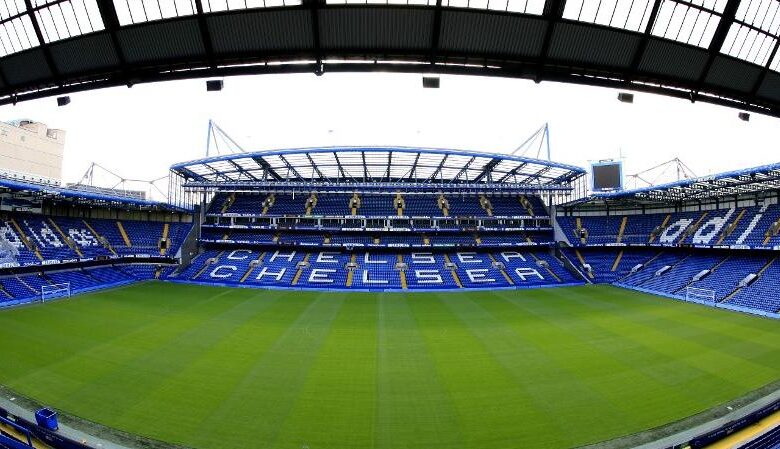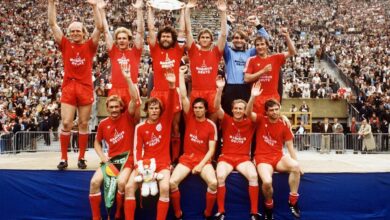Chelsea: Stamford Bridge (stadium) – History

- Chelsea’s Stamford Bridge – History.
Chelsea have only had one home ground, Stamford Bridge, where they have played since the team’s foundation. The stadium was officially opened on 28 April 1877 and for the next 28 years it was used by the London Athletic Club as an arena for athletics meetings.
In 1904 the ground was acquired by businessman Gus Mears and his brother Joseph, who had also purchased nearby land (formerly a large market garden) with the aim of staging football matches on the now 12.5 acre (51,000 m2) site.Stamford Bridge was designed for the Mears family by the noted football architect Archibald Leitch, who had also designed Ibrox, Craven Cottage and Hampden Park. Most football clubs were founded first, and then sought grounds in which to play, but Chelsea were founded for Stamford Bridge.
Starting with an open bowl-like design and one grandstand with seating, Stamford Bridge had an original capacity of around 100,000, making it the second biggest stadium in England after Crystal Palace. The early 1930s saw the construction of a terrace on the southern part of the ground with a roof that covered around 20% of the stand.
As the roof resembled that of a corrugated iron shed, the stand eventually became known as the “Shed End”, although it is unknown who first coined this name. From the 1960s, it became known as the home of Chelsea’s most loyal and vocal supporters. In 1939, another small seated stand was added, the North Stand, which remained until its demolition in 1975.
In the early 1970s, the club’s owners announced a modernisation of Stamford Bridge with plans for a state-of-the-art 50,000 all-seater stadium. Work began in 1972 but the project was beset with problems and ultimately only the East Stand was completed; the cost brought the club close to bankruptcy.
The freehold was sold to property developers and the club were under threat of eviction from the stadium. Following a long legal battle, it was not until the mid-1990s that Chelsea’s future at Stamford Bridge was secured and renovation work resumed.
The north, west and southern parts of the ground were converted into all-seater stands and moved closer to the pitch, a process completed by 2001. The East Stand was retained from the 1970s development. In 1996, the north stand was renamed the Matthew Harding stand, after the club director and benefactor who was killed in a helicopter crash earlier that year.
When Stamford Bridge was redeveloped in the Bates era many additional features were added to the complex including two Millennium & Copthorne hotels, apartments, bars, restaurants, the Chelsea Megastore, and an interactive visitor attraction called Chelsea World of Sport.
The intention was that these facilities would provide extra revenue to support the football side of the business, but they were less successful than hoped and before the Abramovich takeover in 2003 the debt taken on to finance them was a major burden on the club.
Soon after the takeover a decision was taken to drop the “Chelsea Village” brand and refocus on Chelsea as a football club. However, the stadium is sometimes still referred to as part of “Chelsea Village” or “The Village”.
The Stamford Bridge freehold, the pitch, the turnstiles and Chelsea’s naming rights are now owned by Chelsea Pitch Owners, a non-profit organisation in which fans are the shareholders. The CPO was created to ensure the stadium could never again be sold to developers.
As a condition for using the Chelsea FC name, the club has to play its first team matches at Stamford Bridge, which means that if the club moves to a new stadium, they may have to change their name. Chelsea’s training ground is located in Cobham, Surrey. Chelsea moved to Cobham in 2004. Their previous training ground in Harlington was taken over by QPR in 2005. The new training facilities in Cobham were completed in 2007.
Stamford Bridge hosted the FA Cup Final from 1920 to 1922, has held 10 FA Cup Semi-finals (most recently in 1978), ten FA Charity Shield matches (the last in 1970), and three England international matches, the last in 1932; it was also the venue for an unofficial Victory International in 1946.
The 2013 UEFA Women’s Champions League Final was played at Stamford Bridge as well. The stadium has also been used for a variety of other sports. In October 1905 it hosted a rugby union match between the All Blacks and Middlesex, and in 1914 hosted a baseball match between the touring New York Giants and the Chicago White Sox. It was the venue for a boxing match between world flyweight champion Jimmy Wilde and Joe Conn in 1918.
The running track was used for dirt track racing between 1928 and 1932, greyhound racing from 1933 to 1968, and Midget car racing in 1948. In 1980, Stamford Bridge hosted the first international floodlit cricket match in the UK, between Essex and the West Indies. It was also the home stadium of the London Monarchs American Football team for the 1997 season.
The previous owner Abramovich and the club’s then executive board determined that a larger stadium is necessary in order for Chelsea to stay competitive with rival clubs who have significantly larger stadia, such as Arsenal and Manchester United.
Owing to its location next to a main road and two railway lines, fans can only enter Stamford Bridge via the Fulham Road, which places constraints on expansion due to health and safety regulations.
The club have consistently affirmed their desire to keep Chelsea at their current home, but have nonetheless been linked with a move to various nearby sites, including the Earls Court Exhibition Centre, Battersea Power Station and the Chelsea Barracks.
In October 2011, a proposal from the club to buy back the freehold to the land on which Stamford Bridge sits was voted down by Chelsea Pitch Owners shareholders. In May 2012, the club made a formal bid to purchase Battersea Power Station, with a view to developing the site into a new stadium, but lost out to a Malaysian consortium.
The club subsequently announced plans to redevelop Stamford Bridge into a 60,000-seater stadium, and in January 2017 these plans were approved by Hammersmith and Fulham council. However, on 31 May 2018, the club released a statement saying that the new stadium project had been put on hold indefinitely, citing “the current unfavourable investment climate.”
In July 2022, it was reported that the club’s new owner Todd Boehly had appointed American architect Janet Marie Smith to oversee the renovation of the stadium.





